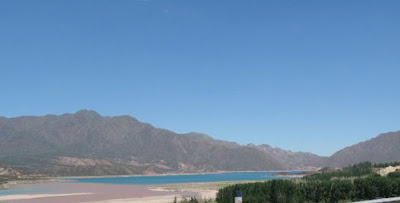Glacial lakes (fed primarily by glacial meltwater) are often a milky blue-green. These surreal lakes captivated me when I visited Torres del Paine National Park in Chile in October 2008. A park ranger explained to me that the unique color comes from suspended sediment, or "rock flour," reflecting sunlight. When I visited Mendoza, in the foothills of the Argentine Andes, in November, I noticed the same color quality in a lake there (see images of Pehoe Lake in Torres del Paine and the lake in Mendoza above). I think that the blue color in the Mendoza lake is probably also related to suspended sediment - there must be impressive erosion from the Andes each year. The lake was fed by a turbid, muddy, braided river. Water color can be affected by a number of factors, such as algal growth, bottom color, and depth, so I can't be sure, but it seems highly likely that the same process of erosion and sediment suspension caused this lovely scene in dry, sunny Mendoza as in the famously harsh landscape of Torres del Paine.


Having only lived in suburbs and cities, I can't help but think that the otherworldy shades of blue in these lakes make them look somehow toxic. But after reading your post, next time I'm at a Superfund site, I'm going to dive in for a swim!
ReplyDelete